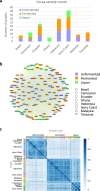Cocoa bean fingerprinting via correlation networks
- PMID: 35075143
- PMCID: PMC8786884
- DOI: 10.1038/s41538-021-00120-4
Cocoa bean fingerprinting via correlation networks
Abstract
Cocoa products have a remarkable chemical and sensory complexity. However, in contrast to other fermentation processes in the food industry, cocoa bean fermentation is left essentially uncontrolled and is devoid of standardization. Questions of food authenticity and food quality are hence particularly challenging for cocoa. Here we provide an illustration how network science can support food fingerprinting and food authenticity research. Using a large dataset of 140 cocoa samples comprising three cocoa fermentation/processing stages and eight countries, we obtain correlation networks between the cocoa samples by computing measures of pairwise correlation from their liquid chromatography-mass spectrometry (LC-MS) profiles. We find that the topology of correlation networks derived from untargeted LC-MS profiles is indicative of the fermentation and processing stage as well as the origin country of cocoa samples. Progressively increasing the correlation threshold firstly reveals network clusters based on processing stage and later country-based clusters. We present both, qualitative and quantitative evidence through network visualization, network statistics and concepts from machine learning. In our view, this network-based approach for classifying mass spectrometry data has broad applicability beyond cocoa.
© 2022. The Author(s).
Conflict of interest statement
The authors declare no competing interests.
Figures




References
-
- Ellis DI, et al. Fingerprinting food: current technologies for the detection of food adulteration and contamination. Chem. Soc. Rev. 2012;41:5706–5727. - PubMed
-
- Medina S, Pereira JA, Silva P, Perestrelo R, Câmara JS. Food fingerprints–A valuable tool to monitor food authenticity and safety. Food Chem. 2019;278:144–162. - PubMed
-
- Sobolev AP, Circi S, Capitani D, Ingallina C, Mannina L. Molecular fingerprinting of food authenticity. Curr. Opin. Food Sci. 2017;16:59–66.
-
- Kongor JE, et al. Factors influencing quality variation in cocoa (Theobroma cacao) bean flavour profile—A review. Food Res. Int. 2016;82:44–52.
-
- Medina S, Perestrelo R, Silva P, Pereira JAM, Câmara JS. Current trends and recent advances on food authenticity technologies and chemometric approaches. Trends Food Sci. Technol. 2019;85:163–176.
LinkOut - more resources
Full Text Sources

